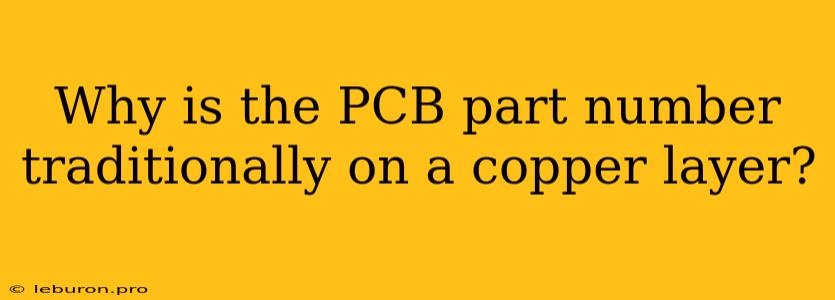The placement of a printed circuit board (PCB) part number on a copper layer is a common practice in the electronics industry, but the reasons behind this tradition might not be immediately apparent. While the part number could be placed on the silkscreen layer, which is a non-conductive layer that serves as a visual guide for assembly, there are several compelling arguments for its inclusion on a copper layer. This article will delve into the reasons behind this practice, exploring the advantages it offers in terms of manufacturing, traceability, and overall circuit board design.
Why is the PCB Part Number Traditionally on a Copper Layer?
The decision to place the part number on a copper layer is rooted in several factors, including:
Enhanced Traceability and Durability
- Permanent Marking: Etching the part number directly into a copper layer ensures that the marking is permanent and cannot be easily erased or altered. This is crucial for maintaining accurate identification and traceability throughout the PCB's lifecycle.
- Resistance to Wear and Tear: Copper layers are inherently more durable than silkscreen layers, which can be susceptible to wear and tear during handling, soldering, and other manufacturing processes. Etching the part number on copper ensures its longevity and visibility even after the PCB has been subjected to harsh conditions.
- Simplified Assembly and Testing: The presence of a clearly defined part number on a copper layer facilitates the identification of the PCB during assembly and testing phases. This can streamline the manufacturing process, minimizing potential errors and ensuring the correct components are used.
Improved Electrical Connectivity
- Enhanced Grounding: In many cases, the part number is placed on a ground plane layer, which acts as a reference point for electrical signals. This can improve electrical connectivity by providing a consistent ground path, reducing noise and improving signal integrity.
- Elimination of Interference: Etching the part number on a copper layer can reduce the potential for electromagnetic interference (EMI) by providing a conductive path for stray signals. This can be particularly beneficial for high-frequency circuits where EMI can be a significant concern.
Manufacturing Considerations
- Etching Process: Etching the part number directly onto the copper layer is a relatively straightforward process that can be readily integrated into the PCB manufacturing process. This eliminates the need for additional printing steps, simplifying production and potentially reducing costs.
- Clear and Consistent Marking: Etching on copper allows for a clear and consistent marking, regardless of the size or complexity of the part number. This ensures that the number is easily legible throughout the manufacturing and assembly processes.
Design Considerations
- Layer Availability: In some cases, the availability of a particular copper layer might influence the decision to place the part number on a specific layer. For example, if a ground plane layer is readily available, it might be the most practical location for the part number.
- Aesthetic Considerations: While less common, some designers might choose to etch the part number on a copper layer for aesthetic reasons, particularly if the PCB is designed to be visible.
Alternative Approaches to Part Number Placement
While placing the part number on a copper layer is the most common practice, alternative methods exist. These include:
- Silkscreen Layer: As mentioned earlier, the part number can be printed on the silkscreen layer, which is a non-conductive layer typically used for visual markings. However, this approach can be susceptible to wear and tear, making it less durable than etching on copper.
- Laser Etching: An alternative to chemical etching is laser etching, which uses a focused laser beam to remove material from the surface of the PCB. This technique can produce very fine details and is often used for more complex markings, but it can be more expensive than traditional etching.
Conclusion
The decision of where to place the PCB part number is ultimately a design choice that must be made on a case-by-case basis, considering factors such as manufacturing process, design complexity, and the desired level of traceability and durability. While using a copper layer remains the most common practice due to its advantages in terms of permanence, electrical connectivity, and ease of implementation, alternative methods exist and should be considered based on the specific needs of the project. Ultimately, the goal is to ensure that the part number is clearly visible, easily readable, and resistant to wear and tear throughout the PCB's lifecycle.
